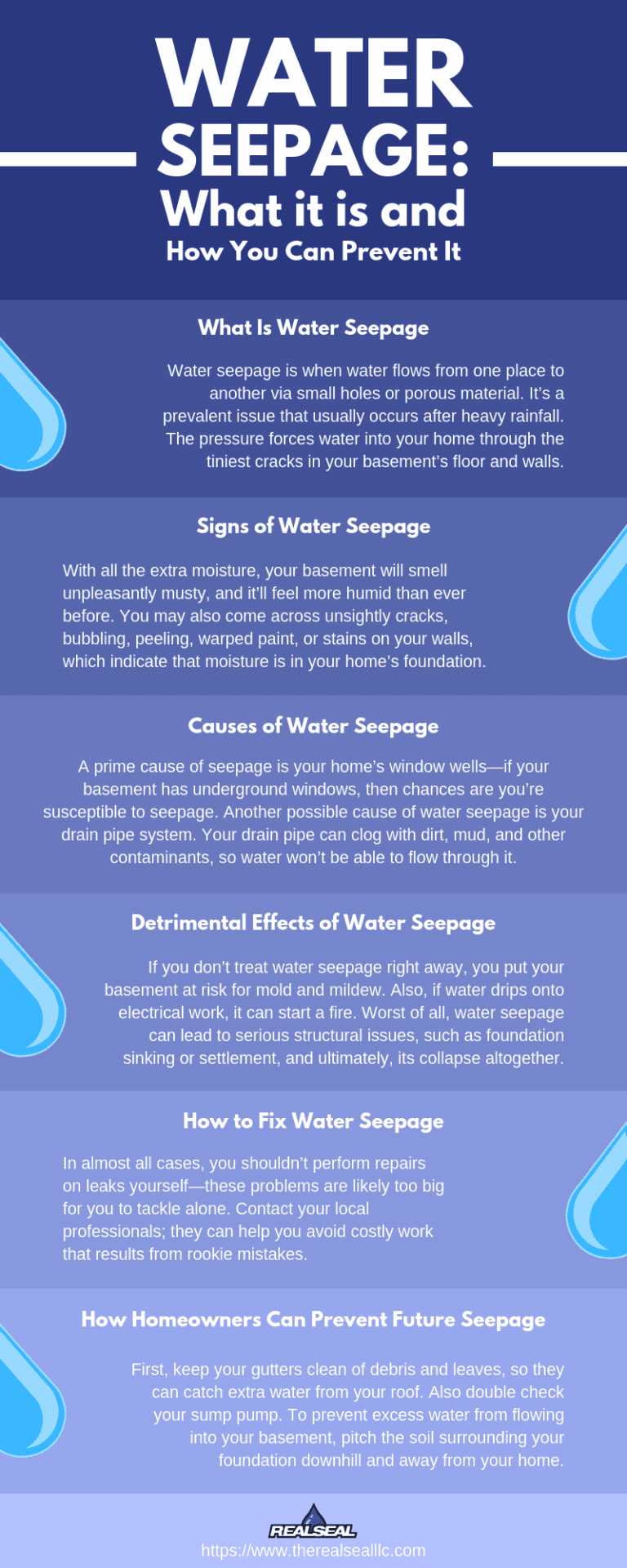Sadly, it’s common for basements to be the first area of a home to experience water damage. As such, we firmly believe that all water-related problems should be at the forefront of homeowners’ minds—after all, a basement provides various benefits for families. We’re going to break down what water seepage looks like and how you can reduce the likelihood that it affects your living space.
What Is Water Seepage?
Water seepage is when water flows from one place to another via small holes or porous material. It’s a prevalent issue that usually occurs after heavy rainfall. Groundwater levels rise, and additional water in the soil creates hydrostatic pressure against your home’s foundation. This pressure forces water into your home through the tiniest cracks in your basement’s floor and walls. Water can also seep over the top of foundation walls.
Signs of Water Seepage
Sometimes, it’s not easy to spot water seepage—thankfully, there are signs you can look for if you’re unsure. With all the extra moisture, you’re sure to notice worsened indoor air quality. Your basement will smell unpleasantly musty, and it’ll feel more humid than ever before. Additionally, you may come across unsightly cracks, bubbling, peeling, warped paint, or stains on your walls, which indicate that moisture is in your home’s foundation. You may also find rust on the appliances that live in your basement. Although there are many signs that indicate moisture-related issues, the most obvious sign of water seepage is a pool of water on the floor.
Causes of Water Seepage
Many factors can contribute to water seepage. A prime cause of seepage is your home’s window wells—if your basement has underground windows, then chances are you’re susceptible to seepage. While manufacturers design window wells to prevent water from flowing into your basement, they can easily collect water during storms, especially if the wells are in poor condition. Clogging, cracking, and improper installation may allow water from the soil to seep into the well, preventing it from draining correctly. As the water fills up in your window wells, it trickles around your basement’s windows. To prevent seepage, homeowners should install window well covers or repair window well liners. These solutions can also aid in extending your windows’ lifespans.
Another possible cause of water seepage is your drain pipe system. A drain pipe collects water and diverts it from your living space through a sump pump system. However, while effective, your drain pipe can clog with dirt, mud, and other contaminants, so water won’t be able to flow through it. Instead, this moisture will seep through your foundation’s walls, your basement’s floor, or the cove joint, which is the opening where your foundation’s floor and walls meet. To remedy this issue, homes should ideally have both interior and exterior drain tile systems.
Detrimental Effects of Water Seepage
No doubt, there are numerous repercussions that come with excess water. If you don’t treat water seepage right away, you put your basement at risk for mold and mildew. Unfortunately, mold isn’t just a cosmetic problem—it can put you and your family’s health in danger. Furthermore, mold cleanup isn’t an easy job; from carpet removal to drywall replacement, getting rid of mold is costly and time-consuming.
Additionally, if water trickles onto electrical work, it can start a fire. Excess moisture can also ruin your personal belongings and lure unwelcome insects and rodents into your home. To avoid pests and to keep your valuables in the best condition possible, you don’t want to leave your basement unchecked after large storms. Immediately look for water damage and start taking steps to mitigate it the moment you notice it.
Worst of all, water seepage can lead to serious structural issues, such as foundation sinking or settlement, and ultimately, its collapse altogether. For example, if wooden joists support your foundation, the water will cause them to rot. These problems can turn into expensive repair projects for homeowners.
How to Fix Water Seepage
When it comes to water seepage, it’s crucial that you act immediately. According to the EPA, “Fixing easily corrected household water leaks can save homeowners about 10 percent on their water bills.” In almost all cases, you shouldn’t perform repairs on leaks yourself—these problems are likely too big for you to tackle alone. Contact your local professionals; they can help you avoid costly work that results from rookie mistakes. Need foundation repair in Chicago or its surrounding suburbs? The Real Seal’s certified technicians will thoroughly examine your home to determine exactly how water made its way into your basement. Then, we’ll use the latest methods and technologies to permanently resolve the issues at hand. With our efficacious solutions, our experts also ensure you don’t experience seepage in the future.
How Homeowners Can Prevent Future Seepage
Of course, the first step to preventing leaks is stopping water in its tracks. To do this, you’ll need to use effective basement waterproofing techniques. First, keep your gutters clean of debris and leaves, so they can catch extra water from your roof. Also, be sure your home’s downspouts can successfully direct water away from your home; they should never drain toward your foundation. If your downspouts don’t extend far enough away from your home, we encourage you to use downspout extensions. Another recommendation we have is to install a dehumidifier, which will regulate your basement’s humidity levels. A ventilation fan can also help with redirecting damp air outdoors.
Double check your sump pump, too. This system minimizes hydrostatic pressure and reduces your basement’s chances of flooding, so it’s important to regularly inspect it. We suggest investing in a back-up system, just in case your original sump pump fails. You should also consider insulating your plumbing to prevent condensation; although seemingly harmless, condensation contributes to mold growth.
Finally, your property’s landscaping plays a large role in how much water enters your living space. To prevent excess water from flowing into your basement, pitch the soil surrounding your foundation downhill and away from your home.








14 Responses
This post really opened my eyes to the issue of water seepage! I never realized how much it could affect my home’s foundation and overall structure. Thank you for sharing those prevention tips; I’ll definitely be checking my property for any signs of seepage!
Glad we could help!
This post was really informative! Water seepage can be such a headache, and I didn’t realize how many preventative measures we could take. The tips on fixing gutters and sealing cracks are especially helpful. Thanks for sharing!
Happy to Help!
Great insights on water seepage! I had no idea how much it could affect my home’s foundation. The prevention tips are super helpful—I’ll definitely be checking my gutters and landscaping. Thanks for sharing!
You’re very welcome!
This is such an informative post! I had no idea that simple things like ensuring proper drainage could help prevent water seepage. I’ll definitely be checking my basement for any signs of moisture now. Thanks for the tips!
Happy to help!
Great insights on water seepage! I had no idea how much it could affect my home’s foundation. I’m definitely going to look into those prevention tips you mentioned, especially the importance of proper drainage. Thanks for sharing!
Glad you got something out of it!
Great insights on water seepage! I never realized how crucial proper drainage is in prevention. Thanks for the tips on checking gutters and downspouts—I’ll definitely be more proactive about it!
Very happy to help!
Great article! Water seepage can be such a headache, and I appreciate your practical tips on prevention. I never realized how important proper drainage is. I’ll definitely be checking my gutters and downspouts!
Happy to help!